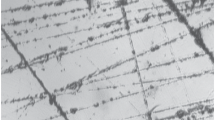Abstract
A single-stage gas-driven setup is developed, which allows 0.5-kg projectiles to be accelerated to velocities of the order of 1200 m/s. Experiments with penetration of steel projectiles into a massive ice target are performed. The experimental data are compared with the results of computations performed by the REACTOR software system and numerical calculations of destruction of a finite-thickness ice target under the impact of one projectile and several projectiles. It is demonstrated that an impact of a steel ring onto a finite-thickness ice target leads to knock-out of the maximum volume of ice and almost complete loss of the kinetic energy of the ring.
Similar content being viewed by others
References
M. Millot, S. Hamel, J. R. Rygg, et al., “Experimental Evidence for Superionic Water Ice Using Shock Compression,” Nature Phys. 14, 297–302 (2018).
E. S. Gaffney, “Hugoniot of Water Ice,” in Ices in the Solar System (Springer, Dordrecht, 1985), pp. 119–148.
S. T. Stewart and T. J. Ahrens, “Shock Hugoniot of H2O Ice,” Geophys. Res. Lett. 30 (6), 1332 (2003).
S. T. Stewart and T. J. Ahrens, “Shock Properties of H2O Ice,” J. Geophys. Res.: Planets 110, E03005 (2005).
V. V. Balandin, S. V. Krylov, E. Yu. Poverennov, and V. V. Sadovskii, “Numerical Simulation of Shock Interaction of an Elastic Cylinder with Ice,” Probl. Pochn. Plastichn. 79 (1), 93–103 (2017).
V. P. Glazyrin, “Shock and Explosive Loading of Ice,” Izv. Vyssh. Uchebn. Zaved., Fiz. 50 (9/2), 60–64 (2007).
A. V. Gerasimov and S. V. Pashkov, “Numerical Simulation of the 3D Process of Projectile Penetration into Ice,” Mat. Model., Kraevye Zadachi, Part 1, 96–08 (2008).
Yu. N. Orlova and V. P. Glazyrin, “Mathematical Modeling of Penetration of a Cylindrical Projectile into Thin Ice,” Tr. Tomsk. Gos. Univ., Ser. Fiz.-Mat. 276, 56–59 (2010).
V. A. Lobanov, “Modeling of Ice Interaction with Structures,” Vestn. Nauch.-Tekh. Razv., No. 10, 31–39 (2011).
E. I. Kraus and I. I. Shabalin, “Reactor2D: A Tool for Simulation of Shock Deformation,” AIP Conf. Proc. 1770, 030092 (2016).
E. I. Kraus and I. I. Shabalin, “The Tool for High-Velocity Interaction and Damage of Solids,” Math. Montisnigri 39, 18–29 (2017).
V. M. Fomin, A. I. Gulidov, G. A. Sapozhnikov, et al., in High-Velocity Interaction of Solids (Izd. Sib. Otd. Ross. Akad. Nauk, Novosibirsk, 1990) [in Russian].
E. I. Kraus, V. M. Fomin, and I. I. Shabalin, “Model Equations of Thermodynamic Functions of State of Matter. 1. Solids” Fiz. Mezomekh. 7, 285–288 (2004).
M. L. Wilkins, Computer Simulation of Dynamic Phenomena (Springer, Berlin-Heidelberg-New York, 1999).
F. R. Tuler and B. M. Butcher, “A Criterion for the Time Dependence of Dynamic Fracture,” Int. J. Fracture Mech. 4 (4), 431–437 (1968).
E. I. Kraus, I. I. Shabalin, and T. I. Shabalin, “Automatic Tetrahedral Mesh Generation for Impact Computations,” AIP Conf. Proc. 1893, 30129 (2017).
E. I. Kraus, I. I. Shabalin, and T. I. Shabalin, “Numerical Analysis of Wave Propagation in a Cermet Composite,” AIP Conf. Proc. 1893 (1), 030130 (2017).
I. E. Khorev, S. A. Zelepugin, A. A. Konyaev, et al., “Destruction of Targets by a Group of High-Velocity Bodies,” Dokl. Akad. Nauk 369 (4), 481–485 (1999).
A. V. Gerasimov, V. N. Barashkov, and S. V. Pashkov, “Impact of a Group of Compact Elements onto a Thin Target,” Izv. Vyssh. Uchebn. Zaved., Fiz. 52 (7/2), 59–63 (2009).
Author information
Authors and Affiliations
Corresponding author
Additional information
Original Russian Text © E.I. Kraus, A.Yu. Melnikov, V.M. Fomin, I.I. Shabalin.
Translated from Prikladnaya Mekhanika i Tekhnicheskaya Fizika, Vol. 60, No. 3, pp. 146–153, May–June, 2019.
Rights and permissions
About this article
Cite this article
Kraus, E.I., Melnikov, A.Y., Fomin, V.M. et al. Penetration of Steel Projectiles through Finite-Thickness Ice Targets. J Appl Mech Tech Phy 60, 526–532 (2019). https://doi.org/10.1134/S0021894419030155
Received:
Revised:
Accepted:
Published:
Issue Date:
DOI: https://doi.org/10.1134/S0021894419030155




